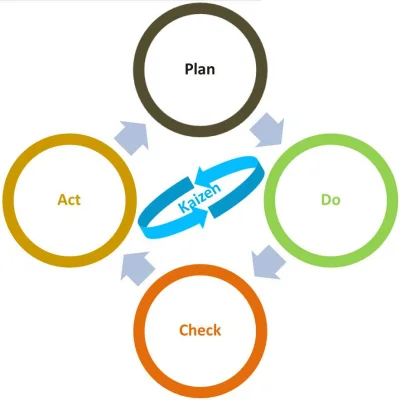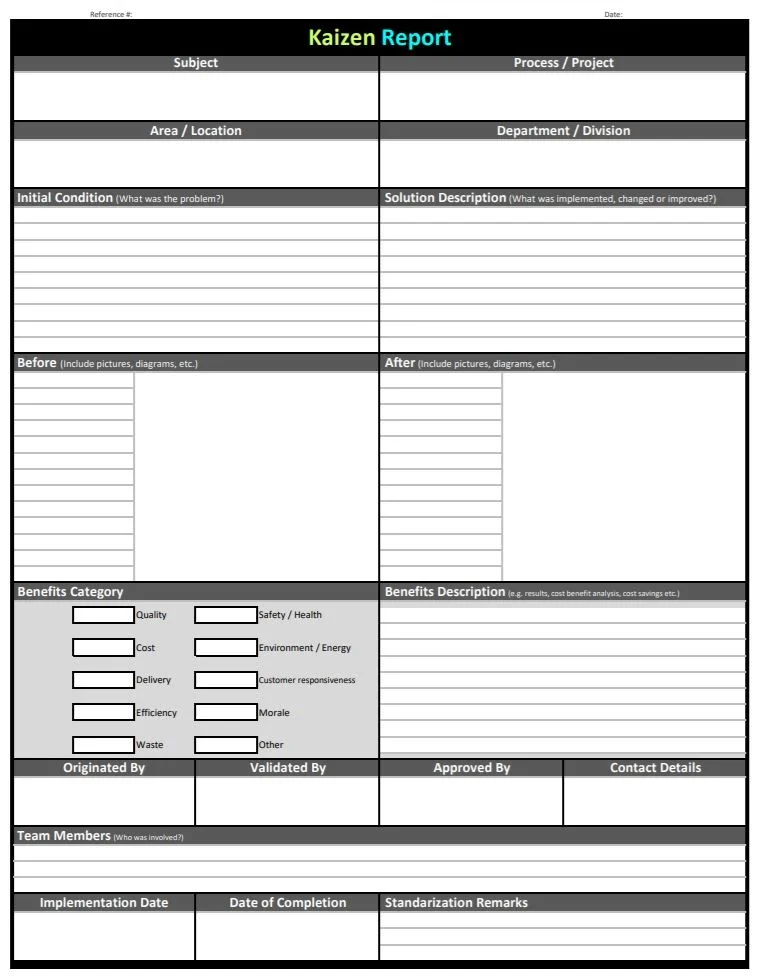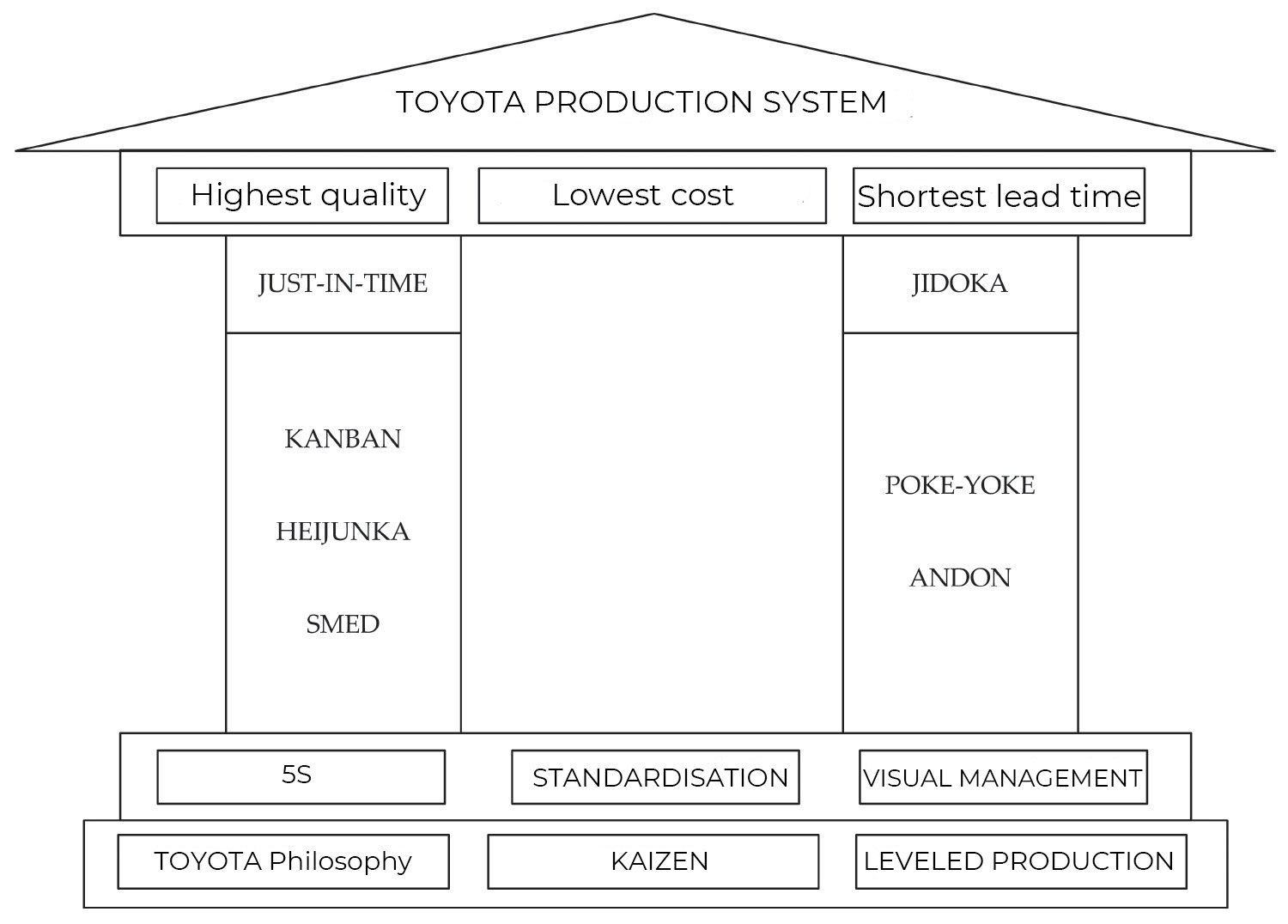In the 1950s, something new was created in the Toyota factories in Japan. Not a workflow, not a new toolbox, but a system that improves and changes through continuous development, agile, almost day by day. The Toyota Production System (TPS), also known as just-in-time production, slowly but fundamentally changed the design and development of production and, over time, service systems.
The meaning of Kaizen
Kaizen is a word of Japanese origin. Zen means "good". And "kai" is a verb meaning "to change". So in mirror translation, Kaizen means "to change is good", but the English translation is more like continuous improvement.
And improvement can be achieved if development proposals are listened to and considered. Business problems must therefore be seen as opportunities and continuously improved.
Kaizen cycle in project management
Since Kaizen is an intermittent activity, several tools and techniques can be used to implement it. One of these techniques is the PDCA cycle, which is composed of the initial words plan, do, check and act.
- Plan = planning
- Do = action
- Check = check
- Act = intervention
It is an iterative, four-step method, also known as the Deming cycle, that supports continuous improvement of processes and products. It is named after W. Edwards Deming, an American engineer and management consultant who worked with Japanese industrial leaders after World War II.

The elements of the cycle are described in more detail in the following steps:
Plan (Plan): team members define the objectives and processes to achieve the desired results.
Action (Do): the team implements the plan, implements the new process(es), tests the changes and collects the data to be measured in the next phase.
Check (Check): the data collected are checked, evaluated and compared with the expected results. The testing process is also evaluated and compared with the original test created during the design phase. If the PDCA cycle is run several times, the data will be monitored for trends.
Intervention (Act): the team identifies any problems, gaps or issues that have arisen and other opportunities for improvement at the Do and Check stage. Root cause analysis is performed and the process is adjusted to eliminate the problems. At the end of this stage, the process can be better defined, documented and implemented/applied. And the next cycle can start where the team designs new goals and processes.
When changing a process, it is important to record both the initial state and the final result. Recording the changes helps to track their impact. To get an accurate picture in hindsight, it is useful to record these changes both pictorially and textually.
Changes/alterations can be made with a before and after status sheet, which can be supplemented with photo documentation.

One of the main drivers of kaizen can be the introduction of a suggestion scheme, which aims to involve employees in the improvement of processes and production systems. In many cases, the suggestion scheme is combined with a reward system for employees, which may also involve moral or financial recognition. It is important to know, however, that a suggestion scheme is not just a matter of putting out suggestion boxes, but must be defined:
- the proposal categories
- the rules for the examination of proposals
- the persons responsible for the assessment
- respond to the proposals
- in case of refusal, the reason must be given
- proposals adopted must be implemented within a short timeframe
- the proposal must include the expected results
- and the result must be verified after implementation
The proposal system also consists of several steps:
- Design
- Execution
- Advertisement
- Education
- Introduction
- Traceability
Kaizen in the project management workflow
Kaizen as an iterative process seems to be more easily applied by teams and companies practicing agile and other iterative methods. For example, some software development teams have combined the Deming cycle with the Scrum approach for continuous improvement. Others use Kaizen as a mindset for continuous improvement, with Kanban and used as a tool to better prioritise work and optimise workflow in a flexible and transparent environment.
But Kaizen is not limited to agile methodology. As a philosophy and action plan, it can be applied to any project team using any methodology. For example, the continuous improvement process can be applied at all stages of the waterfall model. One of the main strengths of kaizen is that the efficiency goal can be achieved continuously and incrementally thanks to the principle of feedback.
Kaizen is a culture that all members of the project team can foster. Each team member should look to improve their own performance. Everyone is encouraged to take ownership of their work, which really promotes teamwork. As individual team members work on personal development, they can also suggest small ideas for improvement that are easier to implement, less likely to result in radical change and require fewer resources or capital.
Implementing the Kaizen principle
The Kaizen learning-focused principle. Learning from mistakes, identifying the source of losses, proactively eliminating them and making operations more efficient. It is based on genchi genbutsu, which means "go and see".
To make Kaizen work in practice, you need an open, trusting leader. A "gemba walk" means that the boss doesn't just work from his office and watch statements, but walks down to the production line, talks to the workers and together they identify the problem. The idea is that the manager experiences the mistakes first hand, because an excellent worker, if he or she performs a bad job or is inefficient through no fault of their own, is equally considered a bad worker.
The gemba Kaizen method therefore means a high level of employee involvement - which in turn improves the morale of the company that implements Kaizen.
Continuous improvement can be sustained by reacting to challenges, and this is where Kaizen can help, by monitoring the process, making decisions based on real-time data and improving the big picture in small steps.
LEAN vs Toyota Production System (TPS) vs Kaizen method
LEAN is a management approach that aims to ensure continuous learning by giving respect to each other. It is driven by supportive leadership and aims to transform a company into a learning organisation.
LEAN is actually nothing more than a "western version" of the Toyota Production System. Its main tools, pillars and methodology are the same, but some of its segments are much more prevalent than TPS, such as customer feedback and quality improvement.
So while TPS focuses on the production line and employee feedback, LEAN measures the success of a company's products from a consumer perspective. After all, it's no use rolling something off the production line perfectly if it doesn't meet the needs of customers afterwards.
It is very common for different but closely related and similar systems to be used incorrectly as synonyms. The illustration of a Toyota system, or Toyota house, helps to understand the relationship and difference between different concepts, methodologies and systems.

The figure above shows the overall TPS, which aims to minimise losses while producing a high quality product at the lowest cost and in the shortest time. Taiichi Ohno built the production system from several elements. These include Just-in-Time, 5S, Kanban and even Kaizen. It can be seen clearly in the diagram that Just-in-Time (JIT), for example, is one of the pillars of TPS, while kaizen is one of the foundations of the production system, and not the whole system itself.
The 7 losses: past and present
What is the 7 loss model? What losses did a company generate in the past and today?
Overproduction
Overcapacity in industry occurs when a company creates more supply than it needs. While in the office example it can also mean that the customer is provided with much more (unnecessary) information than they really need. Over-production is when we send someone emails on a daily basis when they only want to read one email a week.
Shipping
Transport, or rather redundant transport, can increase the time needed to prepare the product, and at office level, the search for contracts and the delivery of documents due to the lack of digitalisation.
Move to
In several portals, the move is presented as a rather superfluous gesture. This can be the search for parts, unnecessary chasing, walking, searching for documents, incorrect sequence of operations, or even the inappropriate functioning of the information flow.
Overwork
Overworking, on the other hand, refers to overly fine machining, or in the case of office work, to multiple data processing, duplicate data sets and their unnecessary complexity.
Waiting for
Waiting for a product to be created can mask a limited flow of information, whether it is the 5W1H (Kipling), i.e. "Who? What? When? Where? Why? How?" questions. We can also wait for the material itself, for maintenance and for acceptance. At the level of a service, the waiting is more about bureaucracy: legal issues, signatures, feedback can get in the way.
Storage losses
Storage losses are caused by the storage of raw materials that are not needed for production, i.e. any stock that "holds the money". Services also represent unused knowledge, unprocessed data, uncompleted projects.
Scrap
Waste is nothing more than a defective product, a lost note, or any factor in the working environment (inadequate lighting, ergonomics) that hinders workers, thus producing wasted time and waste.
Kaizen: method or principle? - summary
In fact, Kaizen is the basis of LEAN and TPS, as it is a principle that everything can and should be improved: with small changes, the whole system can be changed over time and become more efficient.
The watchwords of Kaizen include action, immediacy, and continuous measurement, seeking feedback, and avoiding losses.
As Kaizen is a principle rather than a process or methodology, it can be applied to any business and implemented in the life of any company.
Have a question? Contact us!
Uncertain how to apply kaizen or LEAN well in your company projects? Do you have other questions about process, time or project management? Contact us for more information!

 Designabc
Designabc